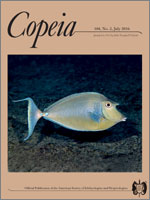Vertebrate mating strategies and life history patterns show great variation within and among species. Variation in reproductive tactics results from a combination of phylogenetic and environmental factors, and detailed natural and life history data among taxa are required to provide a comparative perspective or to infer evolutionary forces. Collection of such data in secretive species can often only be accomplished through long-term monitoring or the use of molecular tools. We used a combination of monitoring via radiotelemetry and microsatellite DNA markers to describe the reproductive ecology of a population of Timber Rattlesnakes, Crotalus horridus, in northwestern Arkansas. Female C. horridus in northwestern Arkansas were smaller at maturity and produce small litters compared to most estimates for other populations. Female snout–vent length and not the body condition of preparturient females was positively related to litter size and total litter mass. Both pregnant females and females found in association with males during the late-summer mating season were in better body condition compared to the general female population, suggesting an energetic component is involved in both female attractiveness and reproduction. Behavioral monitoring of radiotagged females showed that 15% of females engaging in association with a male went on to associate with additional males during that year. At least 44% of females found in association with males did not produce a litter the following year, indicating that females will associate with males (or vice versa) even with little chance of producing a litter the subsequent year. Genetic analysis of eight microsatellite markers confirmed multiple paternity in three of the seven litters analyzed. Males also associated with multiple females in a single mating season. Therefore, the mating system of C. horridus in northwestern Arkansas could probably be best described as polygynandrous.
BioOne.org will be down briefly for maintenance on 17 December 2024 between 18:00-22:00 Pacific Time US. We apologize for any inconvenience.
How to translate text using browser tools
16 June 2016
The Mating System and Reproductive Life History of Female Timber Rattlesnakes in Northwestern Arkansas
Craig M. Lind,
Brenda Flack,
Douglas D. Rhoads,
Steven J. Beaupre
ACCESS THE FULL ARTICLE





